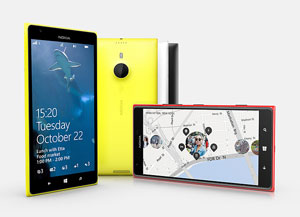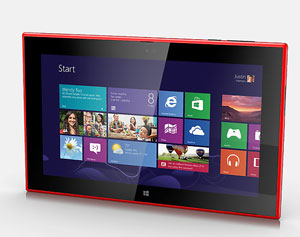Reply To:
Name - Reply Comment
.jpg) Nokia has unveiled its first phablets - extra-large phones - as well as its first tablet computer.
Nokia has unveiled its first phablets - extra-large phones - as well as its first tablet computer.
The Windows Phone handsets introduce the ability to change which objects in a photo are in focus after it is taken.
The Windows RT tablet has a 4G data chip, unlike Microsoft's recently announced Surface 2.
Nokia World in Abu Dhabi is likely to be remembered as the Finnish firm's last major event before it completes the sale of its hardware unit.
Microsoft agreed to buy the business for 5.4bn euros ($7.4bn; £4.6bn) in a deal which the companies have said should be finalised by early 2014.
One analyst said the sale should aid the US firm's efforts to promote its mobile platforms against the market leaders, Android and iOS.
"For the last two years Microsoft and Nokia's marketing efforts have jarred against each other at times - having one big effort should be better than two smaller ones," said Martin Garner, from the consultancy CCS Insight.
"Microsoft can also spend a lot more marketing the devices than Nokia could. That does seem to be a key criteria - both Samsung and Apple's spends are very high indeed."
Microsoft's share of the handset and tablet markets is growing but from a relatively low level, according to market research firm Gartner.
Windows Phone took a 3.3% share of smartphone sales in the April-to-June quarter, said the firm, with Nokia proving the most popular brand.
It also forecast that about 1.7% of all tablets shipped over 2013 as a whole would be powered by either Windows RT or the full Windows 8 operating system.
 Big phones
Big phones
Nokia showed off two phablets at the UAE launch. Both the Lumia 1520 and Lumia 1320 feature 6in (15.2cm) displays, allowing extra rows of apps to be displayed on their home screens than possible on smaller models.
The firm said that the extra space would also make it easier to use the phones' touchscreen keyboards, suggesting this would appeal to business users who used productivity software.
Nokia added that the inclusion of four microphones in the higher-end 1520 should appeal to consumers interested in making recordings of school concerts and other events with multiple sources of sound.
In addition, a new Beamer app will allow the phones to stream the contents of their screens onto to a web browser on a separate display. It works by sending data via Nokia's computer servers.
Another new app - Refocus - lets owners determine which parts of a photograph are in focus and which are blurred after it is taken. The phones achieve this by taking a series of images in quick succession at different focus lengths rather than replicating the light field effect captured by a Lytro camera.
Blackberry is among the other companies to have recently launched a phablet, but one expert said doubts about the Canadian firm's future meant that its existing users might be tempted to switch.
"There's definitely a chance for Nokia to gain ground, of course everyone else is interested in that space too," said Mr Garner.
"It's not a slam dunk, but Microsoft is as well placed as others - better in some respects."
 First tablet
First tablet
The Lumia 2520 becomes the only Windows RT tablet made by a manufacturer other than Microsoft.
Dell, Asus, Lenovo, Acer and Samsung had all initially backed the platform only to later change tack.
The operating system runs on an ARM-based chip allowing it to offer superior battery life to the full Windows 8 system running on tablets powered by x86 processors, but it does not support as many programs.
Nokia's tablet is slightly more compact than Microsoft's version and also distinguishes itself by supporting an optional 4G Sim card.
However, bearing in mind Microsoft has already taken a $900m writedown after weak sales of its original Surface RT tablet, one analyst questioned whether the firm would want to produce two competing models.
"I don't think that having two devices in that space makes a lot of sense," said Carolina Milanesi, consumer devices analyst at Gartner.
"I believe Microsoft may keep the Nokia model on as a cheaper consumer-targeted device focused on media consumption and gaming in order to capture more market share, and also keep on the more expensive Intel-based Surface Pro - but it will phase out the Surface 2 RT model."
More Ashas
Nokia also added three models to its Asha range of low-end handsets targeted at emerging markets and shoppers on a budget. They run Nokia's proprietary Series 40 OS rather than Windows Phone.
The most expensive of the devices, the Asha 530, now supports 3G data in addition to 2G, allowing faster internet access.
Nokia has suggested Microsoft would bring its Skydrive cloud storage service and ability to link up to Xbox games consoles to the handsets following the takeover. But one market watcher questioned their future.
"There's still quite a lot of demand for Asha in developing markets where the phones offer brand-value against other low-cost mass-market handsets," said Chris Green from the Davies Murphy Group consultancy.
"So, there's no sense to killing the business while it remains highly profitable.
"But will it be a core focus? Absolutely not. It will be a distraction and Microsoft will be keen to migrate users to the Windows Phone platform and end Asha out sooner rather than later."
(Source : BBC)